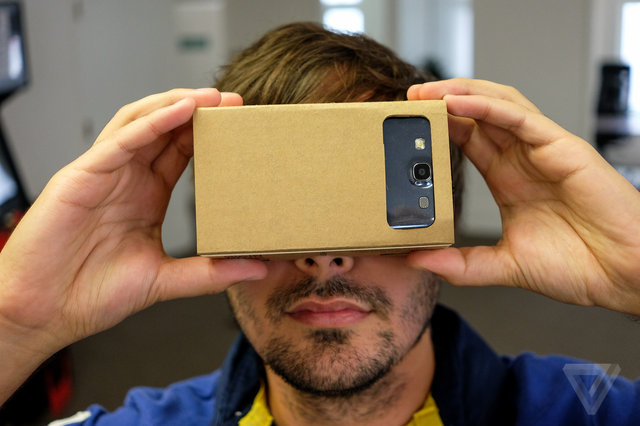Google's Cardboard turns your Android device into a VR headset

While Facebook's virtual reality effort involved a multibillion-dollar purchase of Oculus VR, Google's gone with a decidedly simpler route: cardboard. Following the end of its Google I/O keynote, Google's put out an app called Cardboard that lets users slot their Android device into a do-it-yourself cardboard viewer. When looked through using special lenses, you can interact with various Google services like a VR headset.
THIS IS LOW-COST VIRTUAL REALITY
"Virtual reality has made exciting progress over the past several years. However, developing for VR still requires expensive, specialized hardware," Google said on the project's page. "Thinking about how to make VR accessible to more people, a group of VR enthusiasts at Google experimented with using a smartphone to drive VR experiences."
The result is Cardboard, which in its current state requires some DIY elbow grease, and cannot simply be bought as a completed product. In order to build it you need a pair of lenses with a 40mm focal distance to keep the phone's screen in focus. The kit also requires magnets, velcro, a rubber band, and an NFC tag if you want to tap your device to the headset to launch the app right away. The magnet and rubber band serve as a makeshift hardware button for your phone, something decidedly analog.
Some of the early examples of things you can do with the current iteration of Cardboard:
• Earth: Fly where your fancy takes you on Google Earth.
• Tour Guide: Visit Versailles with a local guide.
• YouTube: Watch popular YouTube videos on a massive screen.
• Exhibit: Examine cultural artifacts from every angle.
• Photo Sphere: Look around the photo spheres you've captured.
• Street Vue: Drive through Paris on a summer day.
• Windy Day: Follow the story (and the hat) in this interactive animated short from Spotlight Stories.
Google says Cardboard was created as part of a 20 percent project, which is when employees can work on side projects alongside their normal duties. Some, like Gmail and AdSense, have ended up as actual Google products. An earlier version of Cardboard was built by David Coz and Damien Henry, two Google employees in Paris. That eventually led to a software development kit for VR experiences, something Google is describing as "experimental."
Cardboard follows in the footsteps of other DIY virtual reality kits, including the FOV2GO, which was created by researcher and USC professor Mark Bolas. Like Cardboard, the FOV2GO makes use of off the shelf lenses and specially cut cardboard or foam core to hold a smartphone in a particular spot. It was unveiled two years ago at the IEEE VR Conference in California, and ended up winning an award for the best demo.
Update June 25th, 6:48PM: With mention of the FOV2GO project.
 “Perception, in whatever sensory modality, is the result of the brain’s cartographic skill.” Antonio Dimasio
“Perception, in whatever sensory modality, is the result of the brain’s cartographic skill.” Antonio Dimasio